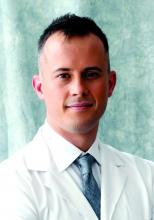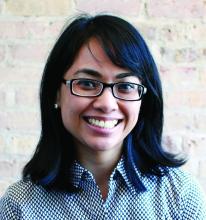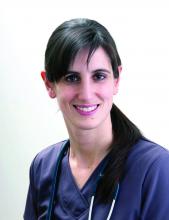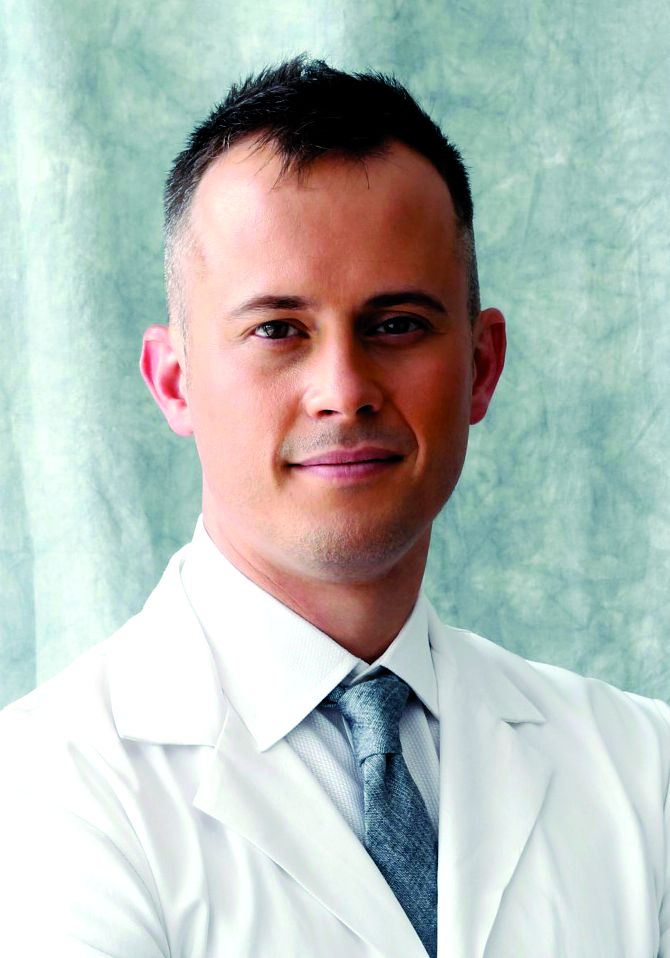User login
To fight burnout, Griffin Myers, MD, wants more out of the physicians who work at Chicago-based Oak Street Health.
Not more time, or more patients, or more codes billed – but more passion and a more meaningful professional experience, said Dr. Myers, cofounder and chief medical officer of the 42-practice group that cares for Medicare patients.
Oak Street seems to be on to something. According to the health care consultancy The Advisory Board, there are three key ways to avoid physician burnout: involve physicians in strategic decision making, recognize physicians’ contributions, and create time-limited leadership opportunities for physicians.
“What do you want to be when you grow up?”
That’s the question Dr. Myers asks physicians during job interviews. He wants to discover their personal and professional passions.
Health care leaders can’t expect physicians to prevent burnout on their own, insists Dr. Myers. “You have to change the way your organization supports clinicians.”
At Oak Street, that includes supporting physicians with medical scribes and ensuring that they aren’t bogged down with paperwork or “fighting with the fax machines,” said Dr. Myers.
Once a physician is hired at Oak Street, they’re partnered with a medical director who uses the practice’s resources to support the physician’s clinical and professional passions. Specifically, that means providing physicians with administrative time (nonpatient time) and support – both organizationally and financially – for professional development. Medical directors meet with physicians quarterly to check in and assess performance.
Take, for example, Tina Valdez, DO, an internist at Oak Street’s Englewood, Ill., location, who previously practiced at Advocate Lutheran General Hospital in Park Ridge, Ill. During the job interview process, Dr. Myers discovered that Dr. Valdez wanted to keep teaching and mentoring residents as they transitioned to attending physicians.
Dr. Myers was on board, so Dr. Valdez uses her administrative time to meet with early-career physicians on a quarterly basis.
Resident physicians are used to having a more senior physician monitor their work, Dr. Valdez noted. Without that oversight, many first-year physicians can get anxious. To support them, she leads small group discussions on topics including patient cases and ways to better work with other members of the care team, such as relying on a medical assistant to capture vital signs and conduct a thorough medication reconciliation.
In the program’s first year, 10 new physicians split into two groups for 2-hour sessions at an off-site meeting location once a quarter.
As much as early-career physicians need support, so, too, do future leaders.
When Andrea Khosropour, MD, first joined Oak Street in 2012, her mentor invested a lot of time in coaching her to become a better leader. For example, her mentor taught her the right way to have difficult conversations.
Dr. Khosropour, now a senior medical director who practices at the group’s Edgewater, Ill., location, said she finds balance at work because Oak Street gives her administrative time to attend to her management responsibilities. She also values the assistance of the medical scribes who document every patient encounter in the EHR. “That’s rare for primary care,” says Dr. Khosropour.
What qualities does Oak Street look for in its physician leaders? Dr. Myers said it starts with a physician who shares the group’s values, demonstrates clinical excellence and “scrappiness,” and has good intentions. He pointed out that Dr. Khosropour, who now oversees four practices, came to Oak Street with no experience running multiple practices.
Dr. Myers said Oak Street can grow its physicians internally as long as they share the group’s cultural values. “You can’t wait for people who already have those skills.”
Oak Street doesn’t rely on a fee-for-service model, in which physicians are paid by the volume of patients they treat. Specifically, that means 80% of its patients are in value-based contracts with private payers and the remaining patients are covered in the Medicare Shared Savings Program. About half of patients are dually eligible for Medicare and Medicaid, Dr. Myers said.
Because the group receives a set amount to manage the care of each of its attributed patients, Oak Street has the flexibility to invest in professional development, scribes, and other programs to support physicians, Dr. Myers said. That’s provided the group can successfully manage the care of their patients and keep them out of the hospital.
He advises practices that are more dependent on fee-for-service contracts to prioritize the following initiatives to prevent burnout: investing in professional development, reducing physicians’ administrative burdens, and celebrating physicians’ victories.
“Our goal is to provide the highest-quality health care employee experience possible. People will stay as long as you set that as a clear goal,” Dr. Myers said.
To fight burnout, Griffin Myers, MD, wants more out of the physicians who work at Chicago-based Oak Street Health.
Not more time, or more patients, or more codes billed – but more passion and a more meaningful professional experience, said Dr. Myers, cofounder and chief medical officer of the 42-practice group that cares for Medicare patients.
Oak Street seems to be on to something. According to the health care consultancy The Advisory Board, there are three key ways to avoid physician burnout: involve physicians in strategic decision making, recognize physicians’ contributions, and create time-limited leadership opportunities for physicians.
“What do you want to be when you grow up?”
That’s the question Dr. Myers asks physicians during job interviews. He wants to discover their personal and professional passions.
Health care leaders can’t expect physicians to prevent burnout on their own, insists Dr. Myers. “You have to change the way your organization supports clinicians.”
At Oak Street, that includes supporting physicians with medical scribes and ensuring that they aren’t bogged down with paperwork or “fighting with the fax machines,” said Dr. Myers.
Once a physician is hired at Oak Street, they’re partnered with a medical director who uses the practice’s resources to support the physician’s clinical and professional passions. Specifically, that means providing physicians with administrative time (nonpatient time) and support – both organizationally and financially – for professional development. Medical directors meet with physicians quarterly to check in and assess performance.
Take, for example, Tina Valdez, DO, an internist at Oak Street’s Englewood, Ill., location, who previously practiced at Advocate Lutheran General Hospital in Park Ridge, Ill. During the job interview process, Dr. Myers discovered that Dr. Valdez wanted to keep teaching and mentoring residents as they transitioned to attending physicians.
Dr. Myers was on board, so Dr. Valdez uses her administrative time to meet with early-career physicians on a quarterly basis.
Resident physicians are used to having a more senior physician monitor their work, Dr. Valdez noted. Without that oversight, many first-year physicians can get anxious. To support them, she leads small group discussions on topics including patient cases and ways to better work with other members of the care team, such as relying on a medical assistant to capture vital signs and conduct a thorough medication reconciliation.
In the program’s first year, 10 new physicians split into two groups for 2-hour sessions at an off-site meeting location once a quarter.
As much as early-career physicians need support, so, too, do future leaders.
When Andrea Khosropour, MD, first joined Oak Street in 2012, her mentor invested a lot of time in coaching her to become a better leader. For example, her mentor taught her the right way to have difficult conversations.
Dr. Khosropour, now a senior medical director who practices at the group’s Edgewater, Ill., location, said she finds balance at work because Oak Street gives her administrative time to attend to her management responsibilities. She also values the assistance of the medical scribes who document every patient encounter in the EHR. “That’s rare for primary care,” says Dr. Khosropour.
What qualities does Oak Street look for in its physician leaders? Dr. Myers said it starts with a physician who shares the group’s values, demonstrates clinical excellence and “scrappiness,” and has good intentions. He pointed out that Dr. Khosropour, who now oversees four practices, came to Oak Street with no experience running multiple practices.
Dr. Myers said Oak Street can grow its physicians internally as long as they share the group’s cultural values. “You can’t wait for people who already have those skills.”
Oak Street doesn’t rely on a fee-for-service model, in which physicians are paid by the volume of patients they treat. Specifically, that means 80% of its patients are in value-based contracts with private payers and the remaining patients are covered in the Medicare Shared Savings Program. About half of patients are dually eligible for Medicare and Medicaid, Dr. Myers said.
Because the group receives a set amount to manage the care of each of its attributed patients, Oak Street has the flexibility to invest in professional development, scribes, and other programs to support physicians, Dr. Myers said. That’s provided the group can successfully manage the care of their patients and keep them out of the hospital.
He advises practices that are more dependent on fee-for-service contracts to prioritize the following initiatives to prevent burnout: investing in professional development, reducing physicians’ administrative burdens, and celebrating physicians’ victories.
“Our goal is to provide the highest-quality health care employee experience possible. People will stay as long as you set that as a clear goal,” Dr. Myers said.
To fight burnout, Griffin Myers, MD, wants more out of the physicians who work at Chicago-based Oak Street Health.
Not more time, or more patients, or more codes billed – but more passion and a more meaningful professional experience, said Dr. Myers, cofounder and chief medical officer of the 42-practice group that cares for Medicare patients.
Oak Street seems to be on to something. According to the health care consultancy The Advisory Board, there are three key ways to avoid physician burnout: involve physicians in strategic decision making, recognize physicians’ contributions, and create time-limited leadership opportunities for physicians.
“What do you want to be when you grow up?”
That’s the question Dr. Myers asks physicians during job interviews. He wants to discover their personal and professional passions.
Health care leaders can’t expect physicians to prevent burnout on their own, insists Dr. Myers. “You have to change the way your organization supports clinicians.”
At Oak Street, that includes supporting physicians with medical scribes and ensuring that they aren’t bogged down with paperwork or “fighting with the fax machines,” said Dr. Myers.
Once a physician is hired at Oak Street, they’re partnered with a medical director who uses the practice’s resources to support the physician’s clinical and professional passions. Specifically, that means providing physicians with administrative time (nonpatient time) and support – both organizationally and financially – for professional development. Medical directors meet with physicians quarterly to check in and assess performance.
Take, for example, Tina Valdez, DO, an internist at Oak Street’s Englewood, Ill., location, who previously practiced at Advocate Lutheran General Hospital in Park Ridge, Ill. During the job interview process, Dr. Myers discovered that Dr. Valdez wanted to keep teaching and mentoring residents as they transitioned to attending physicians.
Dr. Myers was on board, so Dr. Valdez uses her administrative time to meet with early-career physicians on a quarterly basis.
Resident physicians are used to having a more senior physician monitor their work, Dr. Valdez noted. Without that oversight, many first-year physicians can get anxious. To support them, she leads small group discussions on topics including patient cases and ways to better work with other members of the care team, such as relying on a medical assistant to capture vital signs and conduct a thorough medication reconciliation.
In the program’s first year, 10 new physicians split into two groups for 2-hour sessions at an off-site meeting location once a quarter.
As much as early-career physicians need support, so, too, do future leaders.
When Andrea Khosropour, MD, first joined Oak Street in 2012, her mentor invested a lot of time in coaching her to become a better leader. For example, her mentor taught her the right way to have difficult conversations.
Dr. Khosropour, now a senior medical director who practices at the group’s Edgewater, Ill., location, said she finds balance at work because Oak Street gives her administrative time to attend to her management responsibilities. She also values the assistance of the medical scribes who document every patient encounter in the EHR. “That’s rare for primary care,” says Dr. Khosropour.
What qualities does Oak Street look for in its physician leaders? Dr. Myers said it starts with a physician who shares the group’s values, demonstrates clinical excellence and “scrappiness,” and has good intentions. He pointed out that Dr. Khosropour, who now oversees four practices, came to Oak Street with no experience running multiple practices.
Dr. Myers said Oak Street can grow its physicians internally as long as they share the group’s cultural values. “You can’t wait for people who already have those skills.”
Oak Street doesn’t rely on a fee-for-service model, in which physicians are paid by the volume of patients they treat. Specifically, that means 80% of its patients are in value-based contracts with private payers and the remaining patients are covered in the Medicare Shared Savings Program. About half of patients are dually eligible for Medicare and Medicaid, Dr. Myers said.
Because the group receives a set amount to manage the care of each of its attributed patients, Oak Street has the flexibility to invest in professional development, scribes, and other programs to support physicians, Dr. Myers said. That’s provided the group can successfully manage the care of their patients and keep them out of the hospital.
He advises practices that are more dependent on fee-for-service contracts to prioritize the following initiatives to prevent burnout: investing in professional development, reducing physicians’ administrative burdens, and celebrating physicians’ victories.
“Our goal is to provide the highest-quality health care employee experience possible. People will stay as long as you set that as a clear goal,” Dr. Myers said.



